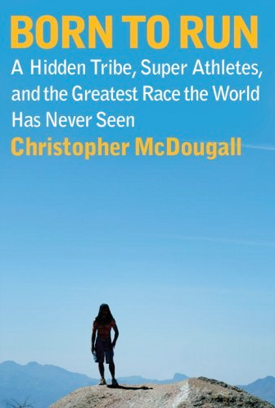Born to Run Marathons?
Right before the New York City marathon, Tara Parker-Pope — ace science writer and editor of The New York Times‘ “Well” section — invited me to crack my knuckles and contribute this essay about my beef with urban mega-marathons. In two words: husbandry and oceanography.
November 4, 2010, 12:01 AM
Born to Run the Marathon?
By CHRISTOPHER MCDOUGALLEven though I’m running better and farther now than I did in my 20s and have been researching, writing and talking about almost nothing but running, I’ve stayed away from the marathon. The distance wasn’t the problem. It was the event itself that bugged me.
Ten years ago, I quit running for good. I was sick of the constant injuries and dismissive shrugs of doctors who wondered, “Well, what did you expect?” One study found that up to 9 out of every 10 marathoners get hurt in training, so how many cortisone shots would it take before I got it through my head that it means something when a sport has a nearly 100 percent casualty rate? The human body wasn’t meant for all the pounding, the doctors kept telling me — especially not 230-pound bodies with nearly 40 years on the meter.
So I took their advice and tossed my Nikes, somehow missing the zoological weirdness in their diagnosis. I never thought to ask, “Hang on — if running is bad for humans, why isn’t it bad for every animal?” Dogs run on sidewalks, elephants trot for miles across baked African savannas, reindeer bound across solid ice on rock-hard hoofs, yet they don’t get shinsplints and Achilles tendinitis. How come every other creature gets along just fine on its own limbs except us?
It would be absurd if trout were at high risk for swimming injuries or 90 percent of blue jays tore their rotator cuffs from flying. Yet humans, who only had their feet for transportation for most of their existence, somehow arrived in the 21st century broken on delivery. Geronimo used to outrun cavalry horses and say, “You can only count on your legs. They’re your only friends.” So why are doctors telling me just the opposite?
In 2005, after years of exile from running, I discovered that Geronimo’s secret is still alive and well among the ultra-running Tarahumara Indians of Mexico’s Copper Canyons. I met their gringo protégé, “The White Horse,” and Daniel Lieberman, Harvard’s “Barefoot Professor,” and discovered that injury-free legs aren’t such a miracle after all. Within nine months, I transformed myself so completely that I was able to join the Tarahumara in a 50-mile race and haven’t missed a day of running due to injury ever since.
Since I told this story in my book “Born to Run,” I’ve been invited to speak at lots of marathons. And at every one of the pre-race dinners, I’d look down from the podium at people who’d handed over a month’s worth of grocery money to be there. They’d been herded through a maze of booths selling worthless and insanely overpriced running shoes, and would be crowded into buses the next morning and wait for hours penned up in corrals — corrals! like cattle! — before being released in waves, so many bodies they’re measured by oceanography — in exchange for…what, exactly?
If you want to run 26.2 miles, the door’s right there. Go. Why do you need corporate hoopla and 45,000 strangers along for the ride?
“I think mega-marathons pretty much epitomize everything that’s wrong with recreational running,” I recently e-mailed Dr. Lieberman, letting him know I’d decided to turn down an invitation to run this year’s New York City marathon with him.
His response was gentle and friendly, but boiled down to this: Get over yourself. What makes you so special that you can’t be part of “the world’s biggest peripatetic party,” as he put it. “Yeah, there is lots of commercialism, sponsors, hype — but to me these marathons are really more like festivals.”
And parties, essentially, are the centerpiece of Dr. Lieberman’s entire theory of human evolution. A big old running party, he believes, is what made our existence possible in the first place. Two million years ago, the brains of early humans dramatically increased in size, meaning they must have been eating other animals: in those pre-tofu, pre-Greek yogurt, pre-cultivated legume days, only flesh could provide enough condensed caloric energy to fuel that many brain cells. But the first spears and arrows only appeared about 200,000 years ago, so how were wimpy little Homo sapiens catching and killing prey without the benefit of claws, fangs, speed, strength or weapons?
Simple, Dr. Lieberman says. We’re really, really good at sweating. Our one natural advantage in the wild was our ability to vent heat by perspiration, instead of respiration. Let a horse run in the sun, and after a few panting miles it has a choice: breathe or cool off. It can’t do both at the same time, but we can. So he believes early humans formed into hunting parties and set off on hot days to chase bounding beasts into heat prostration, trotting along just fast enough to keep them on the move and out of the shade. But the crucial word isn’t “hunting,” but “party.” Try chasing a kudu on your own, and there will be two cadavers on the savanna.
That’s why we feel this urge to gather by the tens of thousands to surge through the city streets for an average of 4.5 hours — which, incidentally, is almost exactly how long it takes to run an antelope to death. You didn’t choose that distance; survival chose it for you.
But when I looked at today’s marathoners, I didn’t see a pack of brothers and sisters pulling together. I didn’t see communal spirit. I saw isolated, iPod-ed individualists more interested in their Garmins than each other. I saw commercial greed and egotistical obsessions over fractions of a minute.
And then I saw Derartu Tulu.
When she entered last year’s New York City marathon, Ms. Tulu was a 37-year-old has-been from Ethiopia who hadn’t won a marathon in eight years. Months earlier, she’d decided to retire. She hadn’t competed for two years after nearly dying in childbirth and was coming to realize she’d never regain the form that sped her to an Olympic gold medal nearly two decades before. But the limits of her aging body were complicated by the demands of a tender heart; in addition to her own two children, she’d adopted four orphans, and one last payday could guarantee her family’s security for a long time. She decided to go for it.
Unfortunately, so did the most formidable female marathoner in history: Paula Radcliffe, the world-record holder and three-time New York City champion. “Lean and mean,” the race announcers said in awe as they watched Ms. Radcliffe rocket off the starting line. “All the other athletes are so intimidated by this great champion. She’s the sharp end of this spear.”
But at mile 22 something strange happened, followed by something even stranger. Ms. Radcliffe grimaced and fell back. Her left hamstring had seized. It was the chance of a lifetime for Ms. Tulu — and she blew it. Instead of blazing toward the finish, she let the lead pack pass while she stopped and waited for Ms. Radcliffe.
“Come on,” she urged the lean, mean spear tip. “We can do it.”
Ms. Radcliffe tried, but her hamstring wouldn’t release. Ms. Tulu finally set off on her own. Somehow, she caught back up with the lead pack, and then the under-underdog blew past in the final quarter-mile to snap the tape. It’s among the most awe-inspiring performances I’ve ever seen, and to this day, I still don’t understand exactly what happened.
The best I can come up with is this: Maybe it wasn’t a coincidence that one of the most compassionate people on the streets that day was also the most competitive. The greatness of spirit which urged her to watch for every faltering orphan, to keep the pack together, also gave her the strength to lead it. At its finest and most time-tested, after all, running was never a solitary pursuit. The Tarahumara don’t compete individually, preferring instead to kick-flip a small wooden ball from teammate to teammate, maintaining a constellation of flowing bodies. The Hopi believed running was a form of prayer; before setting off on a long run from Arizona to the Pacific, they’d offer their effort on behalf of loved ones in need of help. “I’m offering my strength to them,” the runner would murmur to their god, the Great Mystery, “and in return I ask for some of yours.”
I sent Dr. Lieberman another message. “I’m in.”
The real tragedy of the mega-marathon wasn’t too much hype and too many marathoners, but too little and too few. Luckily, the message has recently begun spreading that running can be easy and gentle and injury free, meaning lots more people may soon be joining the party that started them all.
Christopher McDougall is the author of “Born to Run: A Hidden Tribe, Super Athletes, and The Greatest Race the World Has Never Seen.” This Friday, Nov. 5, he’ll host Dr. Lieberman and other speakers in “Running Reinvented: The Cabaret,” at the Society for Ethical Culture on 2 West 64th Street in New York City at 6:30 p.m.


